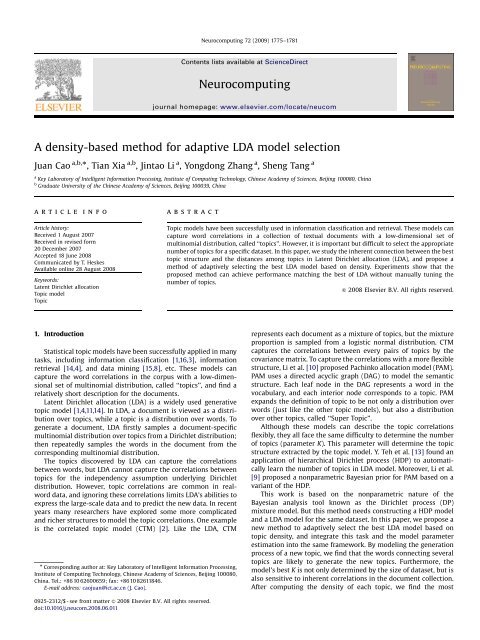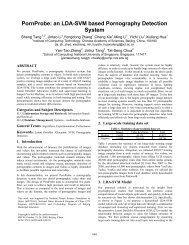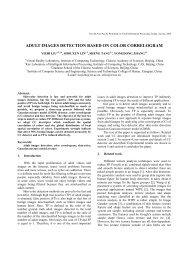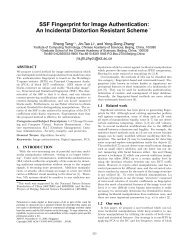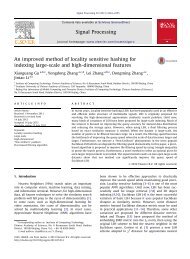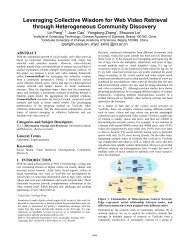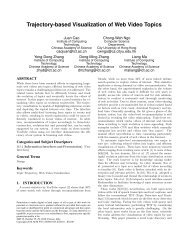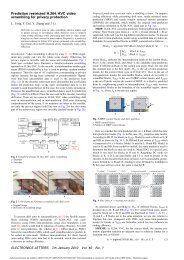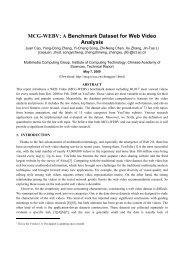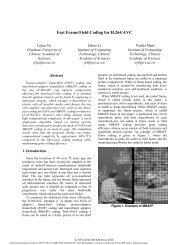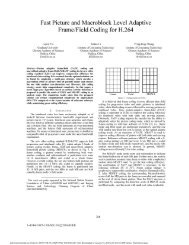A density-based method for adaptive LDA model selection ARTICLE ...
A density-based method for adaptive LDA model selection ARTICLE ...
A density-based method for adaptive LDA model selection ARTICLE ...
You also want an ePaper? Increase the reach of your titles
YUMPU automatically turns print PDFs into web optimized ePapers that Google loves.
<strong>ARTICLE</strong> IN PRESS<br />
Neurocomputing 72 (2009) 1775–1781<br />
Contents lists available at ScienceDirect<br />
Neurocomputing<br />
journal homepage: www.elsevier.com/locate/neucom<br />
A <strong>density</strong>-<strong>based</strong> <strong>method</strong> <strong>for</strong> <strong>adaptive</strong> <strong>LDA</strong> <strong>model</strong> <strong>selection</strong><br />
Juan Cao a,b, , Tian Xia a,b , Jintao Li a , Yongdong Zhang a , Sheng Tang a<br />
a Key Laboratory of Intelligent In<strong>for</strong>mation Processing, Institute of Computing Technology, Chinese Academy of Sciences, Beijing 100080, China<br />
b Graduate University of the Chinese Academy of Sciences, Beijing 100039, China<br />
article info<br />
Article history:<br />
Received 1 August 2007<br />
Received in revised <strong>for</strong>m<br />
20 December 2007<br />
Accepted 18 June 2008<br />
Communicated by T. Heskes<br />
Available online 28 August 2008<br />
Keywords:<br />
Latent Dirichlet allocation<br />
Topic <strong>model</strong><br />
Topic<br />
abstract<br />
Topic <strong>model</strong>s have been successfully used in in<strong>for</strong>mation classification and retrieval. These <strong>model</strong>s can<br />
capture word correlations in a collection of textual documents with a low-dimensional set of<br />
multinomial distribution, called ‘‘topics’’. However, it is important but difficult to select the appropriate<br />
number of topics <strong>for</strong> a specific dataset. In this paper, we study the inherent connection between the best<br />
topic structure and the distances among topics in Latent Dirichlet allocation (<strong>LDA</strong>), and propose a<br />
<strong>method</strong> of <strong>adaptive</strong>ly selecting the best <strong>LDA</strong> <strong>model</strong> <strong>based</strong> on <strong>density</strong>. Experiments show that the<br />
proposed <strong>method</strong> can achieve per<strong>for</strong>mance matching the best of <strong>LDA</strong> without manually tuning the<br />
number of topics.<br />
& 2008 Elsevier B.V. All rights reserved.<br />
1. Introduction<br />
Statistical topic <strong>model</strong>s have been successfully applied in many<br />
tasks, including in<strong>for</strong>mation classification [1,16,3], in<strong>for</strong>mation<br />
retrieval [14,4], and data mining [15,8], etc. These <strong>model</strong>s can<br />
capture the word correlations in the corpus with a low-dimensional<br />
set of multinomial distribution, called ‘‘topics’’, and find a<br />
relatively short description <strong>for</strong> the documents.<br />
Latent Dirichlet allocation (<strong>LDA</strong>) is a widely used generative<br />
topic <strong>model</strong> [1,4,11,14]. In <strong>LDA</strong>, a document is viewed as a distribution<br />
over topics, while a topic is a distribution over words. To<br />
generate a document, <strong>LDA</strong> firstly samples a document-specific<br />
multinomial distribution over topics from a Dirichlet distribution;<br />
then repeatedly samples the words in the document from the<br />
corresponding multinomial distribution.<br />
The topics discovered by <strong>LDA</strong> can capture the correlations<br />
between words, but <strong>LDA</strong> cannot capture the correlations between<br />
topics <strong>for</strong> the independency assumption underlying Dirichlet<br />
distribution. However, topic correlations are common in realword<br />
data, and ignoring these correlations limits <strong>LDA</strong>’s abilities to<br />
express the large-scale data and to predict the new data. In recent<br />
years many researchers have explored some more complicated<br />
and richer structures to <strong>model</strong> the topic correlations. One example<br />
is the correlated topic <strong>model</strong> (CTM) [2]. Like the <strong>LDA</strong>, CTM<br />
Corresponding author at: Key Laboratory of Intelligent In<strong>for</strong>mation Processing,<br />
Institute of Computing Technology, Chinese Academy of Sciences, Beijing 100080,<br />
China. Tel.: +86 10 62600659; fax: +86 10 82611846.<br />
E-mail address: caojuan@ict.ac.cn (J. Cao).<br />
represents each document as a mixture of topics, but the mixture<br />
proportion is sampled from a logistic normal distribution. CTM<br />
captures the correlations between every pairs of topics by the<br />
covariance matrix. To capture the correlations with a more flexible<br />
structure, Li et al. [10] proposed Pachinko allocation <strong>model</strong> (PAM).<br />
PAM uses a directed acyclic graph (DAG) to <strong>model</strong> the semantic<br />
structure. Each leaf node in the DAG represents a word in the<br />
vocabulary, and each interior node corresponds to a topic. PAM<br />
expands the definition of topic to be not only a distribution over<br />
words (just like the other topic <strong>model</strong>s), but also a distribution<br />
over other topics, called ‘‘Super Topic’’.<br />
Although these <strong>model</strong>s can describe the topic correlations<br />
flexibly, they all face the same difficulty to determine the number<br />
of topics (parameter K). This parameter will determine the topic<br />
structure extracted by the topic <strong>model</strong>. Y. Teh et al. [13] found an<br />
application of hierarchical Dirichlet process (HDP) to automatically<br />
learn the number of topics in <strong>LDA</strong> <strong>model</strong>. Moreover, Li et al.<br />
[9] proposed a nonparametric Bayesian prior <strong>for</strong> PAM <strong>based</strong> on a<br />
variant of the HDP.<br />
This work is <strong>based</strong> on the nonparametric nature of the<br />
Bayesian analysis tool known as the Dirichlet process (DP)<br />
mixture <strong>model</strong>. But this <strong>method</strong> needs constructing a HDP <strong>model</strong><br />
and a <strong>LDA</strong> <strong>model</strong> <strong>for</strong> the same dataset. In this paper, we propose a<br />
new <strong>method</strong> to <strong>adaptive</strong>ly select the best <strong>LDA</strong> <strong>model</strong> <strong>based</strong> on<br />
topic <strong>density</strong>, and integrate this task and the <strong>model</strong> parameter<br />
estimation into the same framework. By <strong>model</strong>ing the generation<br />
process of a new topic, we find that the words connecting several<br />
topics are likely to generate the new topics. Furthermore, the<br />
<strong>model</strong>’s best K is not only determined by the size of dataset, but is<br />
also sensitive to inherent correlations in the document collection.<br />
After computing the <strong>density</strong> of each topic, we find the most<br />
0925-2312/$ - see front matter & 2008 Elsevier B.V. All rights reserved.<br />
doi:10.1016/j.neucom.2008.06.011
<strong>ARTICLE</strong> IN PRESS<br />
1776<br />
J. Cao et al. / Neurocomputing 72 (2009) 1775–1781<br />
unstable topics under the old structure, and iteratively update the<br />
parameter K until the <strong>model</strong> is stable.<br />
The rest sections of this paper are organized as follows. In<br />
Section 2, we review the basic principles of <strong>LDA</strong> and the <strong>model</strong><br />
<strong>selection</strong> <strong>method</strong> <strong>based</strong> on HDP. In Section 3, we study the<br />
meaning of the parameter K, and deeply analyze the inherent<br />
connection between the topic correlations and the <strong>LDA</strong> <strong>model</strong><br />
per<strong>for</strong>mance. In Section 4, we propose our approach, and show the<br />
experimental results in Section 5. Finally we draw conclusions and<br />
give our future work in Section 6.<br />
2. Related work<br />
2.1. Latent Dirichlet Allocation (<strong>LDA</strong>)<br />
<strong>LDA</strong> is a generative probabilistic <strong>model</strong>, including a three-level<br />
structure with word, topic and document. In <strong>LDA</strong>, documents<br />
are viewed as a distribution over topics while each topic is<br />
a distribution over words. To generate a document, <strong>LDA</strong> firstly<br />
samples a document-specific multinomial distribution over topics<br />
from a Dirichlet distribution. Then it repeatedly samples the<br />
words from these topics. <strong>LDA</strong> and its variants have been<br />
successfully applied in many works [2,10,15,16].<br />
Fig. 1 is the graphical <strong>model</strong> representation of <strong>LDA</strong>. Given a<br />
corpus D containing V unique words and M documents, where<br />
each document containing a sequence of words d {w 1 , w 2 , y, w Nd }.<br />
Given an appropriate topic number K, the generative process <strong>for</strong> a<br />
document d is as following:<br />
(a) Sample a K-vector y d from the Dirichlet distribution p(y|a),<br />
where y d is the topic mixture proportion of document d.<br />
(b) For i ¼ 1yN d , sample word w i in the d from the documentspecial<br />
multinomial distribution p(w n |y d , b).<br />
where a is a k-vector of Dirichlet parameters, and p(y|a) is<br />
given by<br />
pðyjaÞ ¼ GðP k<br />
i¼1a i Þ<br />
Q k Gða i¼1 iÞ ya 1 1<br />
1<br />
...y a k 1<br />
k<br />
(1)<br />
b is a K V matrix of word probabilities, where<br />
b ij ¼ p(w j ¼ 1|z i ¼ 1), i ¼ 0,1, y, K; j ¼ 0,1, y, V.<br />
<strong>LDA</strong> assumes the topic proportions are randomly drawn from a<br />
Dirichlet distribution, which implies the independence between<br />
topics. But these correlations are very common in real-word data.<br />
For example, the topic ‘‘NBA’’ is often discussed together with<br />
‘‘sports’’, but unlikely co-occurs with ‘‘disease’’. The inconsistency<br />
between assumption and reality makes the <strong>LDA</strong> be sensitive to the<br />
parameter K. CTM replaces the Dirichlet distribution with Logistic<br />
Normal one. After getting the correlation between every pair of<br />
topics through the covariance matrix, CTM can predict not only<br />
the words generated by the same topic, but also the words<br />
generated by the correlated topics. Compared with <strong>LDA</strong>, CTM is<br />
less sensitive to the K. But both cannot automatically select the<br />
number of topics.<br />
2.2. The <strong>method</strong> of selecting best K <strong>for</strong> <strong>LDA</strong> <strong>based</strong> on HDP<br />
Fig. 1. Graphical <strong>model</strong> representation of <strong>LDA</strong> [1].<br />
Teh et al. [13] proposed to determine the best K in <strong>LDA</strong> by HDP.<br />
HDP is intended to <strong>model</strong> groups of data that have a pre-defined<br />
hierarchical structure. Each pre-defined group is associated with a<br />
DP whose base measure is sampled from a higher-level DP. Based<br />
on the similarity between HDP and <strong>LDA</strong> in structure, Teh et al. [13]<br />
used the nonparametric nature to resolve the problem of selecting<br />
appropriate number of topics <strong>for</strong> <strong>LDA</strong>. HDP replaces the finite<br />
topic mixture in <strong>LDA</strong> with a DP, and gives the different mixing<br />
proportions to each document-specific DP. In the experiments of<br />
[13], Teh et al. constructed both the <strong>LDA</strong> <strong>model</strong> and the HDP<br />
<strong>model</strong> on one corpus, and obtained the results shown in Fig. 2.<br />
The posterior sample of the number of topics used by HDP in the<br />
1050<br />
1000<br />
Perplexity on test abstacts of <strong>LDA</strong> and HDP mixture<br />
<strong>LDA</strong><br />
HDP Mixture<br />
15<br />
Posterior over number of topics in HDP mixture<br />
Perplexity<br />
950<br />
900<br />
850<br />
Number of samples<br />
10<br />
5<br />
800<br />
750<br />
10 20 30 40 50 60 70 80<br />
Number of <strong>LDA</strong> topics<br />
90 100 110 120<br />
0<br />
61 62 63 64 65 66 67 68 69 70 71 72 73<br />
Number of topics<br />
Fig. 2. (Left) Comparison between <strong>LDA</strong> and HDP. (Right) Histogram of the number of topics the HDP mixture used over 100 posterior samples [13].
<strong>ARTICLE</strong> IN PRESS<br />
J. Cao et al. / Neurocomputing 72 (2009) 1775–1781 1777<br />
right histogram is just consistent with the best parameter K<br />
of the <strong>LDA</strong> <strong>model</strong> in the left figure (the best number of topics<br />
is 50–80).<br />
Being different from the HDP, our idea is to find the connection<br />
between the <strong>LDA</strong> <strong>model</strong> per<strong>for</strong>mance and the topic correlations,<br />
and <strong>adaptive</strong>ly guide the generation of the topics by the topic<br />
<strong>density</strong> statistics in the parameter estimation process.<br />
3. The relationship between the best K and the topic correlations<br />
Topic <strong>model</strong> can extract the latent topic structures by<br />
analyzing a large scale of statistical data. These structures are<br />
hierarchical and corpus-specific. In a good topic structure of <strong>LDA</strong>,<br />
every topic is an understandable, meaningful and compact<br />
semantic cluster, and is exclusive to each other. The higher layer<br />
needs fewer topics, but the topics are abstract and overlap with<br />
each other, which results in too many correlations to retain the<br />
discriminability; On the other hand, the lower layer needs more<br />
topics, and the topics are more concrete, then the in<strong>for</strong>mation<br />
implicated in one topic is too little (every topic is a sparse vector<br />
in the large word space) to retain the discriminability. The number<br />
of topics determines the layer of the topic structure. So find the<br />
best K is important to the topic <strong>model</strong>.<br />
Fig. 4. Topic structure when K is too large.<br />
3.1. The meaning of parameter K<br />
We show the influence of K on the topic <strong>model</strong> with two<br />
graphs. The following topic structures are extracted from a corpus<br />
with five unique words. We denote the topics as open nodes, the<br />
words as solid nodes, and the dependencies between them as<br />
edges.<br />
Fig. 3 describes the case when K is too small (K ¼ 2). Z 1 and Z 2<br />
overlaps over three words. Moreover, their dependence degrees on<br />
W 1 and W 2 are close. In this structure, the discrimination between<br />
Z 1 and Z 2 is small, and <strong>model</strong> the corpus with this topic structure<br />
will lose much important in<strong>for</strong>mation in original data.<br />
Fig. 4 describes the case when K is too large (K ¼ 4). We find<br />
that the Z 0 2 and Z 0 3 have strong correlation in nature from Fig. 3.<br />
(In Fig. 3, the distribution proportion of W 3 on {Z 1 , Z 2 } is {1, 0}, and<br />
W 4 is {0.9, 0.1}.) But <strong>LDA</strong> cannot capture it while inferring the<br />
document posterior distribution over topics. So this topic<br />
structure cannot represent the original data accurately. On the<br />
other hand, CTM can obtain the correlation between Z 0 2 and Z 0 3<br />
from the covariance matrix, and predict W 3 from W 4 . So CTM can<br />
support more topics.<br />
Fig. 5. Topic distribution over words when K ¼ 2.<br />
Table 1<br />
Word assignment over the topics (K ¼ 2)<br />
Topics<br />
Words<br />
1 Drug clinical patients disease<br />
2 Aids HIV virus<br />
When we update the structure with the red dashed line, the<br />
correlations between topics are deduced, and every topic can<br />
imply more inherently correlative in<strong>for</strong>mation.<br />
3.2. Generation of a new topic<br />
In this section we built three <strong>LDA</strong> <strong>model</strong>s <strong>for</strong> a corpus with<br />
K ¼ 2,3,4, and we will observe the correlation between a new<br />
topic’s generation and the topic distribution over words.<br />
This corpus includes four documents and seven unique words:<br />
Doc1: drug clinical patients<br />
Doc2: drug disease<br />
Doc3: HIV virus aids<br />
Doc4: aids HIV disease<br />
Fig. 3. Topic structure when K is too small.<br />
Fig. 5 is the topic distribution over words when K ¼ 2. The two<br />
topics overlay on the word ‘‘disease’’, and the distribution<br />
proportion is close. It results in a strong correlation between<br />
the two topics, and ‘‘disease’’ is an unstable factor in this topic<br />
structure.<br />
Table 1 shows the word assignment in this topic structure<br />
(W n belongs to topic I ¼ argmax i ðpðW n jZ i ÞÞ).
<strong>ARTICLE</strong> IN PRESS<br />
1778<br />
J. Cao et al. / Neurocomputing 72 (2009) 1775–1781<br />
We use the average cosine distance between every pair of<br />
topics to measure the stability of topic structure:<br />
Fig. 6. Topic distribution over words when K ¼ 3.<br />
P K P K<br />
i¼0 j¼iþ1<br />
ave_disðstructureÞ ¼<br />
correðT i; T j Þ<br />
(3)<br />
K ðK 1Þ=2<br />
A smaller ave_dis shows that the structure is more stable. The<br />
ave_dis of above three topics structure are 0.1195, 0.00014 and<br />
0.279, respectively. Obviously the structure when K ¼ 3 is most<br />
stable.<br />
Table 2<br />
Word assignment over the topics (K ¼ 3)<br />
Topics<br />
Words<br />
1 Drug clinical patients<br />
2 Disease<br />
3 Aids HIV virus<br />
Fig. 7. Topic distribution over words when K ¼ 4.<br />
Table 3<br />
Word assignment over the topics (K ¼ 4)<br />
Topics<br />
Words<br />
1 Clinical patients<br />
2 HIV<br />
3 Aids virus<br />
4 Disease drug<br />
Fig. 6 is the topic distribution over words when K ¼ 3. The<br />
unstable factor in Fig. 5 has been separated from topic 1, and<br />
generates a new topic. In this new structure, the topic distribution<br />
over words has few overlap, and the structure is relatively stable<br />
(Table 2).<br />
Fig. 7 shows that the overlaps in the topics distribution become<br />
serious when K ¼ 4. Furthermore, the word assignment over the<br />
topics in Table 3 tells us that the topics in this structure are not so<br />
meaningful (<strong>for</strong> example, the in<strong>for</strong>mation implying in topic 2 is few).<br />
From the above analysis, we conclude that a new topic of <strong>LDA</strong><br />
is generated from the words connecting several topics (just the<br />
overlap words in the old topic distribution).<br />
We use standard cosine distance to measure the correlation<br />
between topics<br />
P V<br />
v¼0<br />
correðT i ; T j Þ¼<br />
T ivT jv<br />
qffiffiffiffiffiffiffiffiffiffiffiffiffiffiffiffiffiffiffiffiffiffiffi<br />
P<br />
q ffiffiffiffiffiffiffiffiffiffiffiffiffiffiffiffiffiffiffiffiffiffiffi<br />
V<br />
v¼0 ðT ivÞ 2 P<br />
(2)<br />
V<br />
v¼0 ðT jvÞ 2<br />
corre(T i , T j ) is smaller, the topics are more independent.<br />
4. The <strong>density</strong>-<strong>based</strong> <strong>method</strong> <strong>for</strong> <strong>adaptive</strong> <strong>LDA</strong> <strong>model</strong> <strong>selection</strong><br />
We have validated that the best K of <strong>LDA</strong> is correlated with the<br />
distances between topics in Section 3. In this section, we integrate<br />
the idea of clustering <strong>based</strong> on <strong>density</strong> [5] into our <strong>method</strong>, and<br />
propose to <strong>adaptive</strong>ly select the appropriate number of topics in<br />
<strong>LDA</strong> <strong>based</strong> on topic <strong>density</strong>. The aim of clustering <strong>based</strong> on <strong>density</strong><br />
is that the similarity will be as large as possible in the intracluster,<br />
but as small as possible between inter-clusters. This aim<br />
just fit the standard of selecting best topic structure in <strong>LDA</strong>.<br />
A topic is equivalent to a semantic cluster. A larger similarity in<br />
intra-cluster shows that this cluster can represent a more explicit<br />
meaning, and a smaller one between intra-cluster shows that the<br />
topic structure is more stable.<br />
For the convenience of describing our <strong>method</strong>, we introduce<br />
three definitions first:<br />
Definition 1. (Topic <strong>density</strong>). Given a topic Z and the distance r, by<br />
computing the average cosine distance (Eq. (1)) between Z and<br />
the other topics, the number of topics within the radius of r from<br />
Z is the <strong>density</strong> of Z, called Density(Z, r).<br />
Definition 2. (Model cardinality). Given a topic <strong>model</strong> M and a<br />
positive integer n, the number of topics whose topic densities are<br />
less than n is the cardinality of M, called Cardinality(M, n).<br />
Definition 3. (Reference sample). Given a topic Z, radius r and<br />
threshold n, if Density(Z, r)pn, then call the word distribution<br />
vector of Z as a reference sample of topic Z.<br />
The reference sample is not a document vector in the real<br />
dataset, but a virtual point over the word distribution.<br />
Based on these definitions, we describe our <strong>method</strong> as follows:<br />
(1) GivenanarbitraryK 0 , initialize the sufficient statistics by random<br />
[6] <strong>method</strong>, and use the variational EM algorithm [2] to estimate<br />
the <strong>model</strong> parameters, and get the initial <strong>model</strong> <strong>LDA</strong> (a, b);<br />
(2) Regarding the topic distribution matrix â of the old <strong>model</strong> as a<br />
cluster result, we sequentially compute the <strong>model</strong>’s average<br />
cosine distance r1 ¼ ave_dis(b), the densities of all the topics<br />
Density(Z, r1), and the cardinality of the old <strong>model</strong><br />
C ¼ Cardinality(<strong>LDA</strong>,0);<br />
(3) Re-estimating the <strong>model</strong> parameter K <strong>based</strong> on the C. The<br />
updating <strong>for</strong>mula is as follows:<br />
K nþ1 ¼ K n þ f ðrÞðK n C n Þ (4)<br />
f(r) is the changing direction of r. If the direction is negative<br />
(being opposite to the <strong>for</strong>mer), then f n+1 (r) ¼ 1*f n (r), else<br />
f n+1 (r) ¼ f n (r). f 0 (r) ¼ 1.<br />
When the convergence direction is negative, we ascending<br />
sort the topics by the densities, and extract the <strong>for</strong>mer K 0<br />
topics as the reference samples to initialize the sufficient<br />
statistics. When the convergence direction is positive, we<br />
initialize the sufficient statistics by seeded [6] <strong>method</strong>.<br />
(4) Repeat (2) and (3), until the average cosine distance and<br />
cardinality of the <strong>LDA</strong> <strong>model</strong> both converge.
<strong>ARTICLE</strong> IN PRESS<br />
J. Cao et al. / Neurocomputing 72 (2009) 1775–1781 1779<br />
5. Experiments<br />
5.1. Experimental data<br />
We build three datasets on the English ASR texts corpus<br />
of TRECVID2005 [7]. All the texts are pre-processed by<br />
the SMART’s English stoplist and by Porter’s stemming algorithm<br />
[12].<br />
D 0 is the whole English ASR texts corpus, including 20932 shot<br />
documents and 8410 unique words;<br />
D 1 is made up of three judged collections of 0168, 0160 and<br />
0169 in the search task, including 3754 shot documents and 5535<br />
unique words. We divide it into D 1 _train and D 1 _test by 10:1;<br />
D 2 is made up of three judged corpus of 0168, 0165 and 0172 in<br />
the search task, including 4129 shot documents and 5681 unique<br />
words. We divide it into D 2 _train and D 2 _test by 10:1.<br />
Following is the detail of the above five search queries:<br />
0160 ¼ ‘‘Find shots of something (e.g., vehicle, aircraft, building,<br />
etc) on fire with flames and smoke visible’’;<br />
Fig. 8. Comparison of perplexity results of <strong>LDA</strong> <strong>model</strong>s in D1 and D2.<br />
Fig. 9. Comparison between the cures of ave_dis and perplexity.
<strong>ARTICLE</strong> IN PRESS<br />
1780<br />
J. Cao et al. / Neurocomputing 72 (2009) 1775–1781<br />
0165 ¼ ‘‘Find shots of basketball players on the court’’;<br />
0168 ¼ ‘‘Find shots of a road with one or more cars’’;<br />
0169 ¼ ‘‘Find shots of one or more tanks or other military<br />
vehicles’’;<br />
0172 ¼ ‘‘Find shots of an office setting, i.e., one or more desks/<br />
tables and one or more computers and one or more people’’.<br />
Among the three datasets, the sizes of D 1 and D 2 are equal, but<br />
the inherent correlations in D 1 are strong. The size of D 0 is greater<br />
than those of D 1 and D 2 , but the documents in it are more noisy.<br />
In particular, we computed the perplexity [2] of a held-out<br />
test set to evaluate the topic <strong>model</strong>s. The perplexity, used by<br />
convention in language <strong>model</strong>ing, is monotonically decreasing in<br />
the likelihood of the test data, and is algebraicly equivalent to<br />
the inverse of the geometric mean per-word likelihood. A lower<br />
perplexity score indicates better generalization per<strong>for</strong>mance. The<br />
perplexity of a test set D test including M documents is given by<br />
( P )<br />
M<br />
d¼1<br />
perplexityðD test Þ¼exp<br />
pðd dÞ<br />
P M<br />
d¼1 N d<br />
where N d is length of document d; p(d d ) is the probability of the<br />
document d generated by the <strong>model</strong>.<br />
Meanwhile, we measure the stability of the <strong>model</strong>s by the<br />
average cosine distance ave_dis described in Section 3.<br />
5.2. Experimental results<br />
We designed three experiments to validate the points<br />
proposed above:<br />
Experiment 1. We compared the best Ks of different datasets in<br />
two groups of experiments.<br />
Fig. 8 is the contrast between the best Ks in two datasets with<br />
the same size but with different document correlation degrees.<br />
The best number of topics is 100 in D 1 , and is 80 in D 2 . It shows<br />
that the <strong>LDA</strong> <strong>model</strong> need more topics when the inherent<br />
correlations in the corpus are stronger (more topics can make<br />
the topics more material and independent). Moreover, the<br />
perplexity curve of D 1 is wholly higher than that of D 2 , i.e. the<br />
<strong>LDA</strong> per<strong>for</strong>ms worse in the corpus with stronger correlation<br />
between documents. It stems from the limitation of <strong>LDA</strong> that it<br />
cannot <strong>model</strong> the topic correlation.<br />
Meanwhile, we also test the best K in D 0 . We train several <strong>LDA</strong><br />
<strong>model</strong>s with K ¼ 10, 30, 50, 100, 200, 300, 400 and 500 and the<br />
best K of D 0 is 30. It again validates that the best K is not only<br />
relevant with the size of corpus, but also sensitive to the<br />
correlations in the corpus.<br />
Experiment 2. We experiment the inherent connection between<br />
the best K and the average cosine distance of topics in D 1 .<br />
In Fig. 9, we observe the changing trend of the average distance<br />
and perplexity of the <strong>model</strong> with K. The two curves change with<br />
the same rules, and reach the best values at the same K. When the<br />
average distance of the topics reaches the minimum, the<br />
corresponding <strong>model</strong> per<strong>for</strong>ms best.<br />
Experiment 3. We realize our <strong>method</strong> of <strong>adaptive</strong>ly selecting best<br />
K <strong>based</strong> on <strong>density</strong> in D 1 with six experiments. The initial K’s are<br />
10, 50, 100, 200, 300 and 500. All can stop at the best K (K ¼ 100)<br />
after several iterations. If the initial values are closer to the best K,<br />
the iterations needed are less (Table 4).<br />
(5)<br />
Table 4<br />
The results of the algorithm <strong>adaptive</strong>ly selecting best K <strong>based</strong> on <strong>density</strong><br />
Initial K Best K Iterations<br />
10 97 19<br />
50 99 26<br />
100 102 2<br />
200 109 3<br />
300 106 5<br />
500 102 34<br />
6. Conclusions<br />
In the topic <strong>model</strong>, the number of topics is crucial to the<br />
per<strong>for</strong>mance, but finding appropriate value <strong>for</strong> it is very difficult.<br />
In this paper, motivated by the limitation that <strong>LDA</strong> ignores the<br />
topic correlation, we further study the connection between the<br />
<strong>LDA</strong> per<strong>for</strong>mance and the topic correlation, and demonstrate that<br />
the <strong>LDA</strong> <strong>model</strong> per<strong>for</strong>ms best when the average cosine distance of<br />
topics reaches the minimum. We integrate the selecting best K<br />
into the estimation process of <strong>model</strong> parameters, and propose<br />
a new <strong>method</strong> of <strong>adaptive</strong>ly finding the best number of topics<br />
<strong>based</strong> on topic <strong>density</strong>. Experiments show that this <strong>method</strong> is<br />
effective.<br />
However, our <strong>method</strong> is <strong>based</strong> on statistics of the whole<br />
corpus, with no straight<strong>for</strong>ward extension <strong>for</strong> out-of-sample<br />
example. There<strong>for</strong>e, an interesting future work is how to extend<br />
the topic structure when a new document appears. We could<br />
record the topic <strong>density</strong> in<strong>for</strong>mation with a tree, and dynamically<br />
update the <strong>density</strong> tree as the corpus enlarges. This work is<br />
significant <strong>for</strong> the large-scale dataset.<br />
Acknowledgements<br />
This work was supported by the National Basic Research<br />
Program of China (973 Program, 2007CB311100), the National<br />
High Technology and Research Development Program of China<br />
(863 Program, 2007AA01Z416), the National Nature Science<br />
Foundation of China (60873165), and the Beijing New Star Project<br />
on Science & Technology (2007B071).<br />
References<br />
[1] D. Blei, A. Ng, M. Jordan, Latent Dirichlet allocation, J. Mach. Learn. Res. 3<br />
(2003) 993–1022.<br />
[2] D. Blei, J. Lafferty, Correlated Topic Models. Advances in Neural In<strong>for</strong>mation<br />
Processing Systems, vol. 18, MIT Press, Cambridge, MA, 2006.<br />
[3] L. Cai, T. Hofmann, Text categorization by boosting automatically extracted<br />
concepts, Proc. SIGIR 9 (2003) 182–189.<br />
[4] J. Cao, J.T. Li, Y.D. Zhang, S. Tang, <strong>LDA</strong>-<strong>based</strong> retrieval framework <strong>for</strong><br />
semantic news video retrieval, IEEE Int. Conf. Semantic Comput. (ICSC) 9<br />
(2007) 155–160.<br />
[5] M. Ester, H.P. Kriegel, J. Sander, X. Xu, A <strong>density</strong> <strong>based</strong> algorithm <strong>for</strong><br />
discovering clusters in large spatial databases with noise, in: Proceedings of<br />
the Second International Conference on Knowledge Discovery and Data<br />
Mining, AAAI Press, Portland, 1996, pp. 226–231.<br />
[6] /http://www.cs.princeton.edu/blei/lda-c/S.<br />
[7] /http://www-nlpir.nist.gov/projects/t01v/S.<br />
[8] V. Jain, E. Learned-Miller, A. McCallum, People-<strong>LDA</strong>: anchoring topics to<br />
people using face recognition, in: International Conference on Computer<br />
Vision (ICCV), 2007.<br />
[9] W. Li, D. Blei, A. McCallum, Nonparametric Bayes Pachinko allocation, UAI<br />
(2007).<br />
[10] W. Li, A. McCallum, Pachinko allocation: DAG-structured mixture <strong>model</strong>s<br />
of topic correlations, in: International Conference on Machine Learning (ICML),<br />
2006.<br />
[11] F.-F. Li, P. Perona, A bayesian hierarchical <strong>model</strong> <strong>for</strong> learning natural scene<br />
categories, in: Proceedings of the 2005 IEEE Computer Society Conference on<br />
Computer Vision and Pattern Recognition (CVPR), Washington, DC, USA, 2005,<br />
pp. 524–531.
<strong>ARTICLE</strong> IN PRESS<br />
J. Cao et al. / Neurocomputing 72 (2009) 1775–1781 1781<br />
[12] M.F. Porter, An algorithm <strong>for</strong> suffix stripping, Program 14 (1980)<br />
130–137.<br />
[13] Y. Teh, M. Jordan, M. Beal, D. Blei, Hierarchical Dirichlet processes, J. Am. Stat.<br />
Assoc. 101 (476) (2007) 1566–1581.<br />
[14] X. Wei, W. B. Croft, <strong>LDA</strong>-<strong>based</strong> document <strong>model</strong>s <strong>for</strong> ad-hoc retrieval, in:<br />
Proceedings of the 29th SIGIR Conference, 2006, pp. 178–185.<br />
[15] E. Xing, R. Yan, A. Hauptmann, Mining associated text and images with dualwing<br />
harmoniums, in: Proceedings of the 21st Annual Conference on<br />
Uncertainty in Artificial Intelligence (UAI-05), AUAI press, 2005.<br />
[16] J. Yang, Y. Liu, E. P. Xing, A. Hauptmann, Harmonium-<strong>based</strong> <strong>model</strong>s <strong>for</strong><br />
semantic video representation and classification, in: Proceedings of the<br />
Seventh SIAM International Conference on Data Mining, 2007.<br />
Juan Cao, born in 1980 (Ph.D. Candidate). Her research<br />
interests focus on multimedia retrieval and machine<br />
learning.<br />
Jintao Li, born in 1962 (Professor, Ph.D. Supervisor).<br />
His major field includes multimedia processing and VR<br />
technology.<br />
Yongdong Zhang, born in 1973 (Ph.D. Associate<br />
Professor). His major field includes image processing<br />
and video processing.<br />
Tian Xia, born in 1980 (Ph.D. Candidate). His research<br />
interests focus on multimedia retrieval and machine<br />
learning.<br />
Sheng Tang, born in 1972, (Ph.D). His major field<br />
includes multimedia retrieval and video processing.


